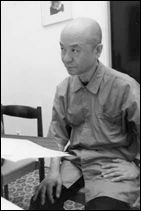|
Aaron Rosand on recital programming: http://www.theviolinchannel.com/vc-masterclass-aaron-rosand-curtis-institute-lost-art-violin-recital-programming/
There's a lot on that page that I disagree with. But instead of arguing with him point-by-point, I thought I would explain my own approach to the art of programming. 1. COHESION. Something must hold the recital together. On recent programs, I've used theoretical concepts (polystylism), dates (music after WWII), and even a cultural narrative (Japan grapples with Western influence) to tie a group of works together. "Alex's favorite pieces" only sells well to my friends; it's hard to market a program that a random piece generator could come up with. 2. CONTRAST. Except under unusual circumstances, I prefer to present contrasting works--no all-Minimalist programs from me! Even when choosing works from a particular time period--say, 1942 to 1952--I look for composers whose differences in style belie the historical proximity of their compositions. Luckily for me, this is very easy to find in the twentieth century! Antithetical to my vision of contrast is a program that consists of three or four violin sonatas. Also antithetical to my vision of contrast are the formulaic recital programs of the past--unless this is done in homage to those old recital programs! I know that any list should have at least 3 items, but I've run out of relevant ideas already. So my last point has not to do with programming, but with recital performance: 3. MEMORIZATION. Not necessary. One should not be glued to the music, but I don't see any reason to show one's memorization skills. (I have on occasion performed from memory, but with music in front of me. That is, I gave the appearance of reading music, while actually performing from memory. Why? To show solidarity with the pianist, who could not memorize as easily as a violinist.) (And why didn't I just use the music? Two words: page turns. And two more words: were impossible.) I do concede occasionally performing from memory, but I am more likely to do this with a contemporary work (Lutoslawski's Subito and Schoenberg's Phantasy) than with a Classical work. These are my thoughts as of today, April 29, 2014. I wouldn't be surprised if I had a completely different approach in 5 years. But this is a snapshot of NOW.
0 Comments
 Today I fired off an email to composer Somei Satoh, whose music will be the topic of my dissertation. I have to admit that I feel quite self-conscious about communicating with my doctoral topic. I intend to present Satoh's works as an intersection of the Western and Japanese musical traditions, and I'm pretty sure that the evidence is in his music. But I haven't yet heard his opinion on this idea! He may be fully in support of it--or he might find the idea ridiculous. Composers are unpredictable when it comes to their music. Some composers, like Elgar, were very relaxed when it came to their music. (Menuhin told a story about preparing a new work by Elgar for its premiere. In the middle of a run-through for the composer, Elgar stopped Menuhin and said something along the lines of "You sound great. It's a beautiful day--I'm going to the races!") Others, like Stravinsky, pulled out their hair when musicians "interpreted" their music. When working with a living composer, I never know which type I'm going to get. (My favorite composers are the ones who leave a small--yet significant!--footprint in my interpretation.) At least when one is writing about Beethoven, one can be certain that the composer won't come running up with a wagging finger! I hope that Satoh-san will be open to my ideas about his music. Fingers crossed! (Wouldn't it be ironic if Satoh read this post? |
These posts are more stream-of-consciousness than polished bits of prose. I'm not doing much proofreading, so please excuse any typos!
Archives
July 2014
Categories |

 RSS Feed
RSS Feed